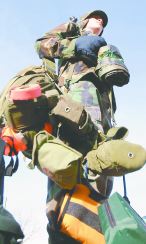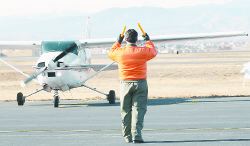
Sherri Barber/The
Coloradoan
A LOT OF GEAR: Master Sgt. Michael Pierce
carries his day pack while listening to instructions for the
exercise.

Sherri Barber/The
Coloradoan
A LOT OF GEAR: Capt. Mike Fassi, acting as
flight marshal, directs a pilot on a runway. Inset, Staff Sgt.
Wade Morris bundles up against the
cold.
|
Colorado's Civil Air
Patrol, the self-dubbed "Eyes of the Home Skies," conducted a series
of high-flying search-and-rescue exercises Saturday at the Fort
Collins-Loveland Airport.
Civil Air Patrol, or CAP, is the civilian auxiliary of the U.S.
Air Force, which is comprised entirely of unpaid civilian
volunteers.
"We are the good guys and we want to help if we can," public
information officer Bruce Hertelendy said. "I don't think you'll
find a more patriotic group of people out there. We just want to do
something good for the country."
CAP has three main missions, Group Commander Howard McClure said.
The first two, cadet training and aerospace education, long have
been part of CAP's undertakings. The third mission, emergency
services, recently was expanded to include homeland security.
David Cohen, CAP's Air Force liaison officer, said it is too
early to tell exactly how that expansion will play out in CAP
operations. He said CAP is still in a "learning mode" of how to
include homeland security priorities.
"We're trying to do things to figure out what other training
we're going to need to take care of," Cohen said. "This is all new.
There are no rules to homeland security as of yet. It all depends on
what the state needs at the time."
More than 150 volunteers participated in Saturday's simulated
search-and-rescue missions in which pilots were sent to locate and
photograph targets, such as broken aircraft, planted on the ground.
The pilots are trained to fly no lower than 1,000 feet above
ground and generally stay in the air for no longer than four hours
at a time.
After they located and photographed their targets, the pilots
landed CAP's signature planes, small-engine Cessna 182s, and got
their "briefings." In the briefings, pilots fed and developed their
digital photographs into a computer. From there, ground volunteers
zoomed in on the photographs to determine if pilots had found their
targets.
The ground volunteers can zoom in a number of times on the
photograph before the picture becomes too pixilated and loses
detail. The pictures cannot, for instance, read the tag letters on a
car license plate. They can make out a body lying on the ground.
CAP was created in 1941 shortly before the Pearl Harbor attacks.
Since then, it has focused primarily on search-and-rescue missions.
Originally published Sunday, January 19, 2003

